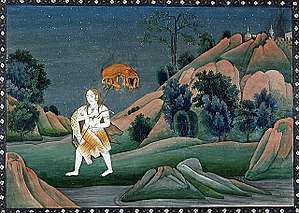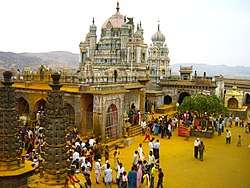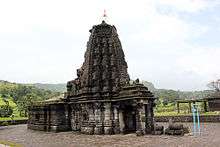Mahur, Maharashtra
| Mahur माहूर | |
|---|---|
| town | |
|
Idol of Renuka goddess in Mahur | |
| Nickname(s): Mahurgad | |
 Mahur Location in Maharashtra | |
| Coordinates: 19°50′52″N 77°55′26″E / 19.84778°N 77.92389°ECoordinates: 19°50′52″N 77°55′26″E / 19.84778°N 77.92389°E | |
| Country |
|
| State | Maharashtra |
| District | Nanded |
| Demonym(s) | Mahurkar |
| Languages | |
| • Official | Marathi |
| Time zone | UTC+5:30 (IST) |
| Vehicle registration | MH- |
| Lok Sabha constituency | Hingoli |
| Vidhan Sabha constituency | Kinwat |
| Civic agency | mahur |
Mahur or Mahurgad is a town and religious place in Nanded district of Maharashtra, India.[1] Mahur is the birthplace of Hindu God Dattatreya.[2] Atri Rishi and Sati Anusaya Mata lived here. Brahmadev, Vishnudev and Lord Shiva once got a news about Anusaya Mata that there is no one more pious and pure as her. To test her piousness they arrived under the garb of asking Alm (bhiksha). When she brought it, they asked to serve them while being naked, she realized by her power that she is under a test. She made them a three headed child & fed them. This became Dattatreya, the unified God.
There are three mountains in Mahur. The first one and most known is having Renuka Mata Temple, who is mother of the god Parshuram. Other two are called Datt Shikhar and Atri Anasuya Shikar Temple's. Mahur has a sacred temple to Renuka Mata, which is considered one of the three and half Shakti Peethas (temples) in the state. A big fair is held here every year on the occasion of Vijayadashami.
When Sahasrarjun attacked Renuka Devi, while somewhere in today's Telangana, for he wanted to grab the Sacred Kamdhenu cow (This Sacred Cow has divine power to fulfill the wish). When Renuka Mata refused to him that saying asking gift of your own choice by the guest visitor is uncalled. He attacked her & injured her. She dies in this & when Lord Parshuram knew about it, he went berserk. Then the elderly people pacified him & asked him to do the last rites in Mahur under Dattatreya's guidance. Then he was told by him that Renuka Mata will appear on first mountain for you to worship. This became the famous Renuka Mata temple. The "Matru Tirth" (means sacred place for Mother's worship) Place on this Mountain is the one which is where today stands a lake, is "Antyeshti Sthan" (Means place where last rites were performed).
There are many other temples in Mahur like Rishi Jamdagni Temple, Lord Parshuram Temple, Kalika Mata Temple, Devdevshwar Temple, and also the Caves called Pandav Leni.
History
Mahur finds mention in the ancient Devi Bhagawatam as "Matripura" or "Matapur", where it is mention as one of the famous pilgrimages.[3] In Devi Gita the final and most important chapter of the text, it is mentioned as one the important places of Shakti worship:
"Devi spoke:... I am now telling something out of My affection to My Bhaktas... Matripura or "Matapur" in the Sahyadri mountain; here the Devi Renuka or Matapur Niwasini Jagdamba Devi dwells..."[4]
Deshmukh of Mahur
Raje Udajiram, a Deshastha Brahmin (Deshmukh) was the Deshmukh of Mahur.Later Pandita Sawitribai Deshmukh was the ruler of Mahur. RaiBagan (Royal Tigress) was an honorary name given by Aurangzeb to Sawitribai Deshmukh after the death of her husband. Sawitribai Deshmukh fought along the side of Aurangzeb against Shivaji.[5]
For Muslims it is famous for the Dargah of Baba SonaPir, who is also known as Mohar-e-Rasool (Stamp of Prophet). In every fifth of the month a Urs has been conducted in Dargaah. Many people come from different parts of country to celebrate this occasion.
The Renuka Devi Temple as a Shakti Peeth

The temple is considered as a revered shrine for the Shaktism sect, because of the above told mythology and also because the Shrine is a Shakti Peetha. It is believed that Renuka Mata, (the wife of Sage Jamadagni) was decapitated by her own son Parashurama and her head fell here. Renuka was later given rebirth as a boon by Sage Jamadagni to his son Parashurama. The temple is considered as a Shakti Peetha because of the mythology of Daksha yaga and Sati's self immolation.[6]
Shakti Peethas are Durga or Adiparashakti shrines that are believes to have enshrined with the presence of Shakti due to the falling of body parts of the corpse of Sati Devi, when Lord Shiva carried it and wandered. There are 51 Shakti Peeth linking to the 51 alphabets in Sanskrit. The Shakti of Mahur is addressed as Renuka Devi. Most of the Shakti Peetha is associated with a Kalabhairava shrine.

Geography
All three important temples — Renuka Mata Temple, Lord Dattatreya Temple and Anusaya Mata Temple — are built on three mountain ranges. Mahur is surrounded by jungles rich with trees and wild life. There is teakwood trees everywhere. Peafowl, deer, black bears, panthers are very common in the jungle.
On one of the mountains is the ancient Mahurgad Fort constructed in the 12th century. Mahur was an important fort in ancient Berar history. It became a separate province in 1478 during the Bahmani Sultanate. It was one of the Sarkars (then district) with 20 parganas (towns) in Berar Subah (state) in Akbar's rule.
Holy Attractions
The main attractions in Mahur are Matapur Niwasini Shri Jagdamba Devi Temple or Renuka Devi Temple, Lord Dattatreya Temple, Anusaya Mata Temple, Devdeveshwar Temple, Lord Parshuram Temple, Sarvatirtha, Matru-Tirtha, Bhanutirth, Hati darvaza, Bal samudra, Pandav Leni, Mahurgad Fort, Mahakali Temple (In the fort), Mahur Museum, Sonapir Dargah, Shaikh Farid Water fall (Wazara), Palace of Raje Udaram. Raje Udaram Deshmukh and later his brave wife RaiBagan (Royal Tigress) were the rulers of Mahur.
People who visit Mahur also visit Unkeshwar Hot Spring (90 km from Pusad; 50 km from Mahur; 15 km from Kinwat), which has natural sources of hot water. This sulphur-rich water is supposed to have medicinal value. The name Unkeshwar is because of Lord Unkeshwar (MAHADEV i.e. Shiva) temple and Aashram complex.
Devdeveshwar Temple
Devdeveshwari mandir belongs to Mahanbhav Panth, basically called a nidra sthan (sleeping place) of Jagat Guru Shree Dattatreya Prabhu. It is at elevated outskirt of Mahur town, 2 km from Mahur bus stand.
Daily Shree Dattatreya Prabhu will take nitya snan (daily bath) at meruwada talao (tank) in Mahur, bhiksha (the meal served to a sadhu or Indian monk) at Kolhapur, bhojan (lunch) at Panchaleshwar and get back to sleep in Devdeveshwar mandir Mahur (nidra sthan of God Dattatreya Prabhu). Jagat Guru Shree Dattatreya swami is a chiranjiv avtar (Immortal) so it is believed that even today Shree Dattatreya swami comes to sleep here.
Travel facilities and Pilgrimage Amenities
There are Maharashtra state transport buses that go from Nagpur, Amrawati, Akola, Nanded, Kinwat, Yavatmal and Pusad to Mahur. Although the District of mahur is Naded, for all practical purposes it is unwise to go to Nanded for going to Mahur. For people from Mumbai it is better to reach Shegaon ( a religious place for Gajanan Maharaj) by train & take a Bus or taxi from there. For Pune visitors, take a train Pune -Amravati & get down at Washim. From there it's about 80 km by road (one can take a bus or taxi from Washim).
Hadgaon also has bus and taxi transport going to Mahur. The only way to approach Mahur is by Road. There are frequent buses (State-run ST buses as well as private buses) from Yavatmal and Pusad.
Accommodation facilities are available in Mahur city (7 km from the temple). All types of accommodation facilities are available like lodges, hotels, government rest houses. For more luxurious options, at a distance of about 70 km, Yavatmal is the best option. Foods served by local hotels, Dhabas (roadside eateries for the travelers) are of good quality and served fresh.
On auspicious occasions like Navaratris, Datta Pournima; Mahapuja is organised which is followed by Mahaprasad (Feast for the Pilgrims).
References
- ↑ https://www.maharashtratourism.gov.in/treasures/temple/mahurgad
- ↑ http://www.sreedattavaibhavam.org/mahurgud/
- ↑ Devi Bhagawatam, Ninth Book, chapter XXXIV: On the description of the various hells, p. 939 Devi Bhagawatam, tr. by Swami Vijnanananda, (1921-22).
- ↑ Devi Gita, chapter XXXVIII: The Vow and the Sacred Places of the Devi Devi Gita (Song of the Goddess), excerpt from the Srimad Devi Bhagawatam, translated by Swami Vijnanananda (Hari Prasanna Chatterji), 1921. "O King of Mountains! Still I am now telling something out of My affection to My Bhaktas. Hear. There is a great place of pilgrimage named Kolhapura in the southern country. Here the Devi Laksmi always dwells. The second place is Matripura or Matapur in the Sahyadrî mountain; here the Devî Renuka dwells." Verses: 3-10.
- ↑ A.R.Kulkarni (2008). Medieval Maratha Country. Diamond Publications. p. contents.
- ↑ "Kottiyoor Devaswam Temple Administration Portal". kottiyoordevaswom.com/. Kottiyoor Devaswam. Retrieved 20 July 2013.
- www.srtmun.ac.in
Official Website
External links
| Wikimedia Commons has media related to Mahur, Maharashtra. |
- Mahur, in Nanded Maharashtra Govt. Official website.
- Mahur Fort The Official Website of Maharashtra Tourism.
- Mahur map

